Published: October 22, 2024 | Last Updated on: October 22, 2024 | by Hema
It is frustrating when your good li’l sleeper goes on a sleep strike! Baby Sleep Regression is a normal part of development – here’s how to handle it.
Jump To hide Baby Sleep Regression: What You Should Know What is Baby Sleep Regression? What causes Baby Sleep Regression? When does Baby Sleep Regression happen? 3 to 4 months 6 months 8 to 10 months 12 months 18 months 24 months Signs of Baby Sleep Regression Tips to deal with Baby Sleep Regression During the Day At Night Sleep Training Buy Healthy Nutritious Baby, Toddler food made by our own Doctor Mom !After the initial days post-childbirth, you and your baby have finally settled into a routine. You think that the worst is behind you, and now you can get some quality sleep at night.
But that’s when it hits – baby sleep regression!
⭐ Download FREE Recipe Ebooks for Babies & Toddlers

Your good sleeper has suddenly decided they don’t want to sleep, and you’ve turned into an exhausted, confused mess. The good news is that sleep regression is just a temporary phenomenon, and you and your baby will soon be past this stage.
To deal with sleep regression in babies, it helps to arm yourself with more knowledge on the subject. So read on to know more about what causes sleep regression, what it looks like, and how you can manage it.
Baby Sleep Regression: What You Should Know

What is Baby Sleep Regression?
Sleep regression can be defined as a significant change in sleep patterns over a period of time. When a baby who has been sleeping relatively well starts having trouble with sleep that goes on for a few weeks, it can qualify as baby sleep regression.
Sleep regression isn’t really a medical term, but it is used to refer to sleep disturbances like struggling to sleep, waking more frequently, or refusing to nap.
But this isn’t as bad as it sounds – sleep regression is often a sign of quick growth and a developing brain!
For us adults, two body processes work to control sleeping and waking – homeostatic and circadian. These include the body clock that signals that nighttime is for sleep, and daytime (sunlight) is for staying awake. However, these processes aren’t fully developed in babies, and till they are, babies are vulnerable to changes in sleeping patterns.
What causes Baby Sleep Regression?

- Growth spurts, leading to increased hunger and night feeds
- Teething troubles like sore gums
- Developmental milestones like crawling, sitting or walking
- Disruptions in routines, like potty training or moving to a new place
- Major life changes, such as getting a new sibling or starting daycare
- Separation anxiety
- A growing desire for independence, especially in older babies
- Colic pain
- Illnesses like viral infections, stomach troubles or fever
It is important to differentiate between sleep regression and a few difficult nights. The word ‘regression’ indicates that the child had been sleeping well so far, and has now ‘regressed’. Sleep regression also lasts at least 2 weeks or more.
When does Baby Sleep Regression happen?
As mentioned earlier, sleep regression often coincides with developmental milestones, which mostly occur at certain specific ages in babies.
3 to 4 months

This right here, the four-month regression, is probably the first time you’ll come face to face with the phenomenon that is baby sleep regression. It is the most significant one, since this is where your baby’s sleep patterns change permanently.
Newborn infants sleep mostly in deep sleep cycles, while adults move through deep and light sleep cycles. Around 3-4 months of age, babies begin to transition into the adult style of sleep cycling, as their circadian rhythm matures. This transition can result in more wakefulness and a general disruption of existing sleep patterns.
If your baby has been used to being fed or rocked to sleep, you may have more trouble with sleep, till they figure out how to soothe themselves. While this is the most common type of sleep regression, some babies may not go through it at all, while others may experience it a month earlier or later.
6 months
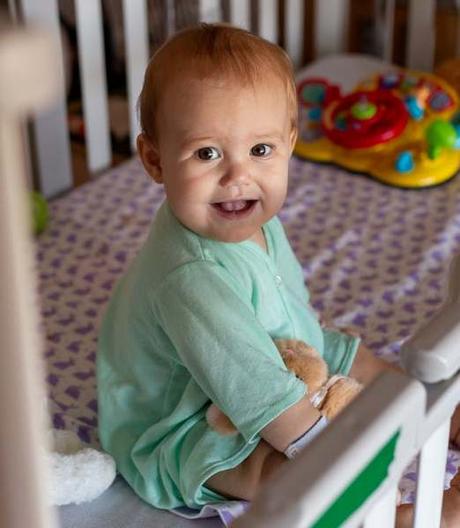
By 6 months, most babies are capable of sleeping for 6-8 hours straight, but this is also the age when a growth spurt may occur. This results in babies getting hungry at night and waking up more frequently to feed. Even if your baby has started solids, it’s likely to be a very small amount, and they’ll still need to be fed at night.
Another reason for baby sleep regression at this age is teething, which starts at 6 months and go on till one year. The discomfort of the new teeth cutting through the gums can wake them up and make them cranky.
8 to 10 months

As babies approach the nine-month mark, they may begin to stay awake for longer and drop a nap. This can disturb their usual sleep routine, creating a period of sleep regression. They often refuse to lie down to sleep and get anxious when the parent leaves the room – separation anxiety also peaks at this stage.
This is an active age for babies – they’re crawling around and may be trying to pull themselves up to a standing position. These newfound skills often leave them too excited to sleep and they may want to practice them at night. Teething is still a problem for babies at this age, with the central incisors popping out before the first birthday.
12 months

The first birthday is a major milestone – both developmentally and otherwise! Babies are usually standing by now, and many are also taking their first steps. One-year-olds are very active and mobile, and this extra energy and excitement may interfere with settling down for bed.
Babies are also more aware of their surroundings, so they may be reluctant to sleep and miss out on the fun. They may show all signs of sleepiness and tiredness but will outright refuse to sleep!
18 months
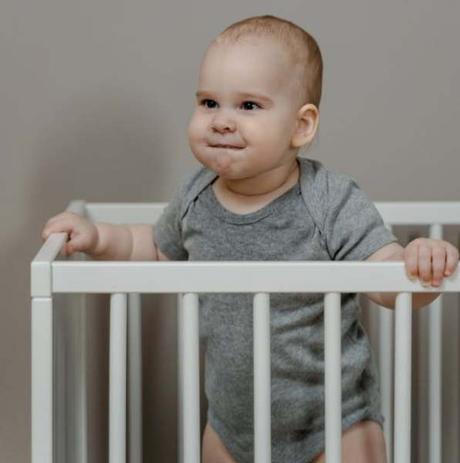
We know that the four-month sleep regression is mainly due to a change in the baby’s circadian rhythm, and something similar happens around 18 months of age. Now, REM and NREM sleep phases may change your child’s sleeping patterns, along with fewer naps during the day.
Toddlers also experience separation anxiety and will want their parents close by. They’re asserting their independence at this stage, and are beginning to test boundaries. You’ll find that they’re quite rebellious – especially during bedtime!
24 months

For most children, the 2-year sleep regression is the last one they’ll have. At this age, the main causes are major changes in their daily routines or lives. Starting to potty train, moving to a big bed or starting daycare are some reasons kids go through a sleep regression at this age.
Two-year-olds generally exhibit sleep regression by skipping naps, stalling during bedtime and generally saying ‘No’ to everything. They may also have fears which prevent them from settling down for sleep – fear of the dark or monsters, for instance.
Other reasons still apply at this age, like separation anxiety and teething, as the molars start pushing through the gums.
Signs of Baby Sleep Regression

When we talk of sleep regression, we speak generally of ‘sleep difficulties’; here’s what they actually mean:
- Difficulty falling asleep at night
- Frequent waking during the night
- Reluctance in napping
- Shorter naps
- More fussiness, especially on waking up
- Overall less sleep time
- Crying when a parent leaves the room
- Seems to dislike bedtime
It’s important to remember that not all babies will exhibit the same signs. Some babies may already be poor sleepers, and a sleep regression may not cause a big difference. Others may be excellent sleepers and the usual causes of baby sleep regressions may not affect them. Every baby is different, and you just have to deal with the situation at hand!
In any case, baby sleep regression is only temporary, and is a good sign that your baby is growing normally. A sleep regression episode usually lasts for 2-4 weeks – this also changes from baby to baby.
Tips to deal with Baby Sleep Regression
During the Day

1. Keep your home bright during the day, by letting in as much sunshine as possible – sunlight helps the brain figure out the circadian rhythm.
2. Ensure your baby stays full during the day so they don’t get hungry at night. Ensure nursing times are quiet and distraction-free so the baby can fill up.
3. As babies get older, they get more active and excited about their newfound mobility. Give them enough opportunities to play and practice their new skills throughout the day.
4. When baby starts showing signs of sleepiness, move them to a quiet place and help them naturally settle down into a nap. Don’t wait till they’re over-tired and get cranky.
5. Adjust your baby’s naps as they get older, so there is a good balance between rest and activity in the day. By bedtime, they should be neither too tired or too rested.
6. Make sure there is enough active time between the last nap and bedtime so baby can sleep well at night.
7. Spend extra time with your baby during the day so they feel secure in your company and are less affected by separation anxiety.
8. When introducing something new in your child’s life, do it one at a time. Whether it is potty training, moving to a bigger bed or starting daycare, don’t introduce multiple changes at once.
At Night
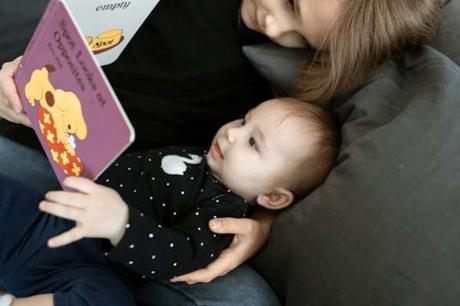
1. Avoid overly stimulating activities or rough play at least an hour before bedtime. If you can, dim the lights in your home a little, so it becomes easier for your baby to wind down.
2. Create a bedtime routine that is easy, practical and doable – and follow it consistently. It could be as simple as bathtime, pajamas, book, feed and lights out. Follow the same steps in the same order every night so your baby gets to know that it’s time to sleep.
3. Along with maintaining a consistent routine, it is also important to keep bedtime at the same time every night. This is crucial in helping your baby fall asleep naturally at night.
4. Keep baby’s room dark – use blackout curtains if required. Keep screens turned off or out of the room, since blue light from screens can disturb a baby who’s trying to fall asleep. If your little one is scared of the dark, keep a dim nightlight on.
5. It’s good to have a quiet room for your baby to sleep, but some babies aren’t comfortable with pin-drop silence. In this case, you can use a white noise machine that will provide a low sound that will drown out other noises and help baby fall asleep.
6. Along with light and noise, another important thing to consider is the temperature of the room. Make sure it is on the cooler side and that your baby is dressed appropriately for the weather.
Sleep Training
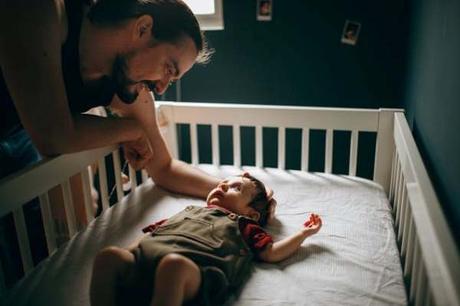
1. Learn to identify baby’s sleep cues – these are usually signs like eye-rubbing, yawning, and general fussiness. Identifying these cues as soon as they appear is crucial to ensure you can get baby to bed before being overtired.
2. If your baby sleeps in a crib, put them down when they’re sleepy but still awake. This trains them to fall asleep when they’re on their own in their crib.
3. Four months is a good time to start sleep training your baby. There are multiple methods for sleep training – try one for at least two weeks before going for another.
4. If your baby wakes up during the night and starts crying, hold for a few minutes before going in. Let them fuss and try to go back to sleep on their own. If it doesn’t work, go in and comfort them, and when they’ve calmed down, put them back to sleep.
5. For older kids who have nightmares or other fears, talk to them and help them cope with their fears. Don’t dismiss them – listen to what they have to say and show them that you understand their feelings.
As for you, the parents, it’s important to share responsibilities so that one parent alone isn’t bearing the brunt of sleepless nights. Take turns waking up during the night when baby cries, and adjust your daily routine around baby’s schedule.
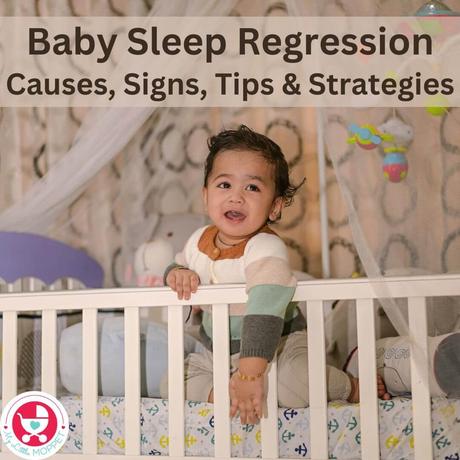
Baby sleep regression isn’t exactly something that can be prevented, but it can certainly be managed! The fact that it is temporary should give you some solace. It’s a normal part of development and needs no other treatment as such. However, if the sleep regression has been continuing for more than four weeks despite all your efforts, you may want to ask your doctor for any additional tips.
Buy Healthy Nutritious Baby, Toddler food made by our own Doctor Mom !
Shop now!You may also like
- 15 Best Sleep Products for Parents to Unwind and Relax

- How to prepare for adoption? Tips for prospective parents

- Teaching Kids about Covid-19 - Tips for Parents

- Your Complete Guide to Baby Sleep Training

- How to Prevent Baby Spitting Up Curdled Milk - A…

- How to Discipline your Child - Strategies that Actually Work

Filed Under: Baby Tagged With: baby, Baby Development, baby health, baby sleep
